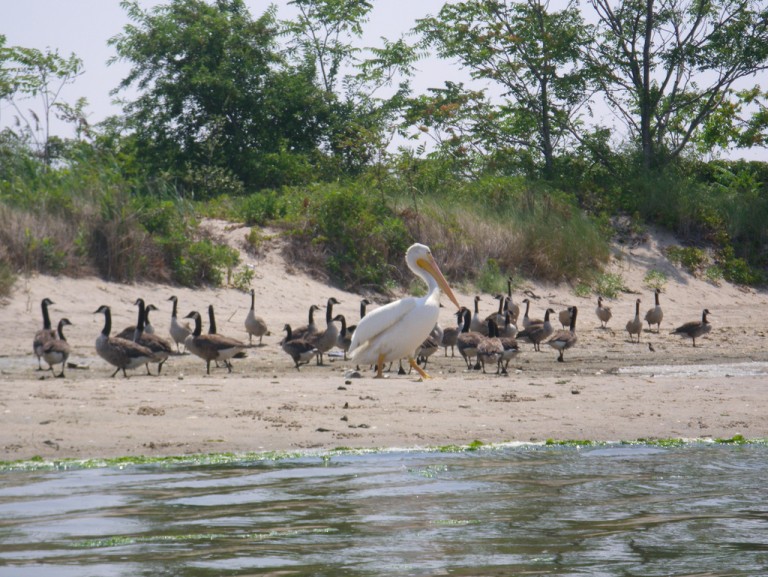Photo: A pelican and Canada geese on a shoreline in Jamaica Bay Wildlife Refuge. Photo Courtesy of bkfrogma, flickr.com
It’s time for some heavy-duty weeding.
The National Parks Service plans to restore a 14 acre area in the Jamaica Bay Refuge Center between West Pond and Cross Bay Boulevard which has become overgrown with vines and other invasive species.
The wildlife refuge is a local – and national – treasure, home to 330 species of birds and more than 100 species of fish, and yet accessible by public transportation to over eight million New Yorkers. The National Parks Service, in partnership with the Nature Conservancy and the Jamaica Bay-Rockaway Parks Conservancy, plans to plant 20,000 native plants by the end of the project in 2018. They will use both manual removal of invasive plants and targeted spraying of herbicides.
“We’re hoping that as volunteers come in to do some of the planting, maybe they’ll take ownership of that little spot and go back year after year to see how the plants that they helped plant are growing,” said Mark Christiano of the National Parks Service at last week’s Broad Channel Civic Association meeting.
An invasive species is one that is not native to a certain environment and doesn’t have predators or natural barriers to prevent its population from overtaking an area. Invasive species often outcompete natural species and have an undesirable effect on its new environment. The Parks Service will use Glyphosate, also known as Roundup, on stumps of removed trees to keep new growth from sprouting out of the stump. They will spray Triclopyr on leaves and vines. Christiano said the herbicides will be very contained so they don’t harm the native plants. The project will be completed in phases to minimize the disturbance to animals in the area.
There will be an emphasis on maintaining the North and South Gardens after the project is complete, because otherwise the area will fall back into disarray, noted Christiano.
“This project will have implications beyond Jamaica Bay by demonstrating how land management strategies on coastal parklands and natural areas can enhance their resilience to climate change,” said Emily Nobel Maxwell, Director of The Nature Conservancy’s New York City Program. “With more frequent flooding, sea level rise and severe storms predicted for New York City, this work has potential applications for the City’s 520 miles of coastline and beyond.”
People can volunteer with manual and mechanical removal of plants, planting native species, and participating in public outreach and education.
“We can go to Twitter, we can go to Facebook, we can talk all we want, but at the end of the day… you folks talking about it is a huge part,” Christiano said. “You’re our best advocates out in the community.
By Greg Zwiers

